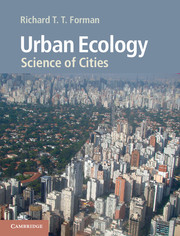Book contents
- Frontmatter
- Dedication
- Contents
- Foreword
- Preface
- Acknowledgments
- Part I Framework
- 1 Foundations
- 2 Spatial patterns and mosaics
- 3 Flows, movements, change
- Part II Ecological features
- Part III Urban features
- Epilogue
- Appendix A Positive and negative attributes of an urban region
- Appendix B Equations
- References
- Index
3 - Flows, movements, change
Published online by Cambridge University Press: 05 June 2014
- Frontmatter
- Dedication
- Contents
- Foreword
- Preface
- Acknowledgments
- Part I Framework
- 1 Foundations
- 2 Spatial patterns and mosaics
- 3 Flows, movements, change
- Part II Ecological features
- Part III Urban features
- Epilogue
- Appendix A Positive and negative attributes of an urban region
- Appendix B Equations
- References
- Index
Summary
Thanks to the automobile, cities no longer have to dispose of tons of horse manure every day.
Virginia I. Postrel, Reason magazine editor, speech for City Club of Cleveland, Ohio, 19 June 1990And then the tidal wave appeared as a high wall of foam rushing towards them, and soon it was on them, on everyone, crashing onto the land, crushing houses, sweeping huts away, drowning cattle and people … Yet, a kind of miracle, most trees – the palms, the bunches of pandanus with great stalking roots, the sweeps of mangroves – were left undisturbed by the same wave that swept away fortress-like walls and paved roads.
Paul Theroux, Ghost Train to the Eastern Star, 2008The nature of flows and movements
Imagine a walk in the city and suddenly reaching a spot where nothing moved. People, leaves, birds, air, water, vehicles, and clouds are absolutely still. Weird, even scary. Better stop and look sharp. Flows and movements around us are universal, never stop.
Processes in urban areas are in effect flows, movements and transport through space (Forman, 1999; Ball, 2009). Some are mainly vertical, including rainfall, evapo-transpiration, tree falls, and ecological succession. Horizontal flows, the focus here, generally cross heterogeneous space thus linking different land uses and habitats (Wegner and Merriam, 1979).
- Type
- Chapter
- Information
- Urban EcologyScience of Cities, pp. 65 - 90Publisher: Cambridge University PressPrint publication year: 2014



